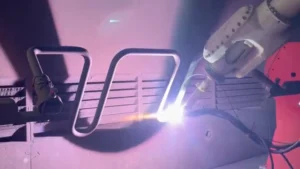table of contents
- Heading 1
- Heading 1
- Heading 1
share this
Due to COVID-19, social distancing has become the new normal. In many countries, lockdowns have been imposed. As more people stay at home and shop online, there is an increase in demand for e-commerce. Along with the many orders to fulfil, enhanced social distancing rules and worker safety are of the utmost priority for many supply chain and logistics companies. [1] Hence, it is undeniable that robot employees have become indispensable to efficient operations in the supply chain.
Main Advantages of Autonomous Robots in the Supply Chain
- Fills the gap in labour shortage
- Higher efficiency and better productivity
- Improves worker safety by reducing the number of human workers in the same work environment
- Redistribute higher-value work to human workers
- Improve revenue by boosting order fulfillment rates, delivery speed and customer satisfaction
This article introduces three important robot employees in the supply chain industry.
1. The Picking Expert
In warehouse operations, the most common robot employee is the pick-and-place robot. They are in charge of case picking and piece picking.
Case picking is an order picking process in which products in full case quantities are picked. Case picking is often used in distribution centres that serve retail or eCommerce stores. [2]
On the other hand, piece picking involves picking individual items and placing them in a container before shipping them off to customers. [3]
Some notable picking robots include the Universal Robots and the Ocado grocery picking robot.
DCL Collaborative Robots
DCL Logistics, a third-party logistics company that provides fulfilment services was in need of a flexible system that could cater to client’s changing needs. As a result, they sought Universal Robots’ UR10e cobots which were deployed to handle pick and packing of items into boxes. [4]

Universal Robot UR 10e deployed between two work cells at DCL logistics. Image by DCL Logistics, Universal Robots
The cobot is placed in between two work cells and in front of a conveyor that carries boxes. It picks up a product from one of the work cells every six seconds and scans them before placing them into the box. The setup runs 24/7 without the need for any human interaction, improving efficiency.
Since its integration, the company has seen a 500% increase in productivity, 50% labour savings, and a three months ROI
Ocado Grocery Picking Robot
Ocado, an e-commerce grocer based totally online in the UK, has developed a smart robotic arm that uses suction to pick groceries.

Ocado Grocery Picking robot lifting a grocery item. Image by Robotics Business Review, Ocado
A suction cup at the end of the articulated arm sucks and lifts each grocery item from the storage crate. The robot then scans the item to identify it. Due to its built-in sensors that minimise the risk of damaging items, it is able to transfer the items safely into customer crates. As each item takes around five seconds to move, this makes it as fast as a human picker over time. [5]
This grocery picker works in Ocado’s highly automated warehouses manned almost entirely by robots. Its human counterparts are only in charge of packing the groceries into bags.
2. The Sorting Machine
The sorting process in FedEx involves the use of robotic sortation arms from Yaskawa America and Plus One Robotics to pick and transfer small parcels from bins onto conveyor belts. This deployment was mainly to ensure that workers maintain a safe distance between each other and also to meet the demands of operation scaling as carriers were designated as essential services. [6]

A Yaskawa robot sortation arm picking up a parcel. Image by FedEx
The four robotic arms use suctions to pick and place small parcels from bins into conveyor belts, covering the work done by three human workers.
3. The AI-powered Arm
Another example is the Kindred Sort robot, which involves a smart AI robotic arm that sorts multi-SKU (stock-keeping unit) batches into individual orders. Pilots are employed to control the robot’s gripping functions and these movements are recorded by Kindred’s machine learning software. These robots are taught how to grip different kinds of objects in the best possible way [7]Gap, an American worldwide clothing retailer, currently employs Kindred Sort robots in its sortation system to automate the sorting of more than 13 million units of merchandise between January 1 and April 30, 2020.
Final Thoughts
In short, the COVID-19 pandemic is nothing like we’ve seen before. This crisis has accelerated the adoption of robotics in many warehouses and retail stores, such as Walmart. As more case studies of automation surface, businesses should learn to also adapt to these changing times and invest in robotics and automation in their supply chain to make long-term growth sustainable.
“I think automation and robotics could be really, really critical in keeping a healthy robust supply chain.” Herman Herman, director of the National Robotics Engineering Center at Carnegie Mellon University [8]
The future of the supply chain, as Amazon rightly puts it, is one where “humans and robots work harmoniously to get packages to customers on time.”
About Augmentus
Augmentus offers a no-code and fully-integrated robotic programming software that enables anyone, even those with no robotic experience, to program dynamic industrial robots in minutes. Our proprietary technology incorporates an intuitive graphical interface on an iPad that eliminates the need for coding and CAD files in robot teaching. Companies using Augmentus have experienced up to 70% cost reduction and 17 times faster deployments across a wide variety of applications, such as spraying, palletizing, welding, and inspections. Augmentus ushers in a new era of human-machine interface, democratizing robotic automation.
Book a demo now to experience it.
References
- [1] Warehouse Robots Provide Crucial Link In Supply Chain
https://www.forbes.com/sites/richblake1/2020/05/20/warehouse-robots-provide-crucial-link-in-supply-chain/?sh=64605fa35d22 - [2] What is Case Picking?
https://www.lucasware.com/warehouse-order-picking-introduction/what-is-case-picking/ - [3] What is piece picking?
https://6river.com/what-is-piece picking/#:~:text=Piece%20picking%20is%20an%20order,distribution%20center’s%20total%20operating%20expenses. - [4] Universal Robots Delivers 500% Productivity Increase at DCL Logistics
https://www.universal-robots.com/case-stories/dcl-logistics/ - [5] Ocado’s New Grocery Robot Can Pick, Pack 50,000 Items
https://www.roboticsbusinessreview.com/news/ocado-grocery-robot-pick-pack/ - [6] FedEx installs robotic arms for automated parcel sorting to handle rising e-commerce volume
https://www.supplychaindive.com/news/fedex-robotic-arm-sortation-parcel-coronavirus/581836/ - [7] Kindred AI is using human pilots to do what robots can’t
https://www.technologyreview.com/2018/02/13/67298/kindred-ai-is-using-human-pilots-to-do-what-robots-cant/ - [8] Robots, automation seen as solutions to social distancing hurdles in supply chain
https://www.supplychaindive.com/news/robots-automation-social-distancing-pandemic/581531




